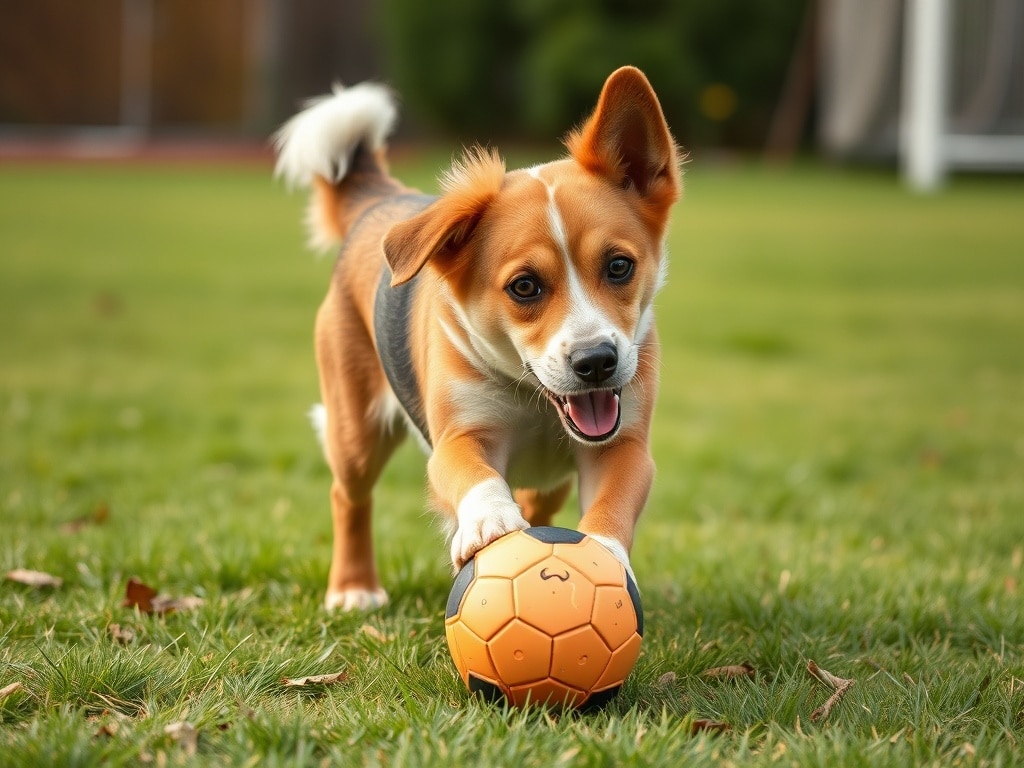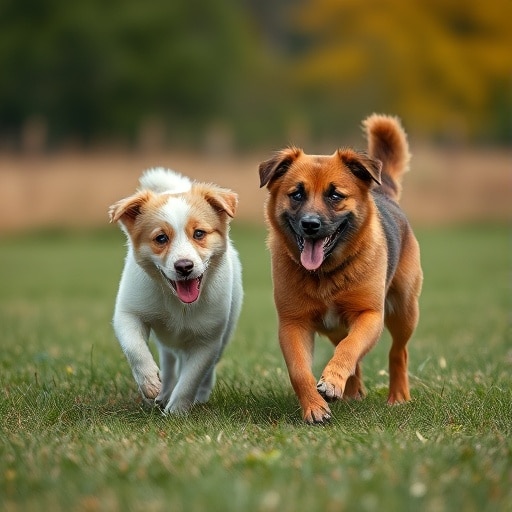Unleash Your Dog's Potential: The Ultimate Exercise Guide by Age & Breed
Introduction to Dog Exercise: Why is it Important?
Imagine your dog's boundless energy as a vibrant river. Exercise is the channel that guides that river, preventing it from flooding into destructive behaviors or stagnating into a pool of boredom and health problems. A well-exercised dog is generally a happier, healthier, and better-behaved companion. Just like humans, dogs need regular physical activity to maintain their physical and mental well-being. Exercise helps prevent obesity, strengthens muscles and bones, improves cardiovascular health, and reduces the risk of certain diseases. But even more than that, it provides mental stimulation, reduces stress and anxiety, and strengthens the bond between you and your furry friend. Without adequate exercise, your dog might become restless, destructive, or even develop behavioral issues like excessive barking or chewing. Think of a bored child confined indoors all day – the same principle applies to our canine companions. This dog exercise guide will equip you with the knowledge to tailor the right amount of activity to your dog's specific needs, based on age and breed.
Dog Exercise Needs by Age: Puppy Exercise (0-6 Months)
Puppies are bundles of joy, but their exercise needs are significantly different from adult dogs. Their bones and joints are still developing, making them vulnerable to injury from high-impact activities. Instead of long runs or strenuous hikes, focus on short, frequent play sessions.
- Short Walks: Several times a day, lasting no more than 5-10 minutes each.
- Playtime: Engage in gentle playtime with toys, focusing on retrieving and tug-of-war.
- Socialization: Expose your puppy to different environments, people, and other dogs in a controlled and safe manner. This helps them develop into well-adjusted adults.
The key is to let your puppy set the pace and avoid pushing them too hard. Watch for signs of fatigue, such as panting, lagging behind, or lying down. Remember, mental stimulation is just as important as physical exercise for puppies. Puzzle toys and training games are excellent ways to keep their minds engaged.
Dog Exercise Needs by Age: Adolescent Dog Exercise (6-18 Months)
The adolescent phase is often the most challenging for dog owners. Your puppy is growing rapidly and has seemingly endless energy. This is the time to gradually increase the intensity and duration of their exercise.
- Longer Walks: Increase the length of walks to 20-30 minutes.
- Play Dates: Arrange supervised playdates with other dogs to help them burn energy and socialize.
- Training Sessions: Enroll in obedience classes or practice training exercises at home. This provides mental stimulation and strengthens your bond.
Be mindful of your dog's breed and individual needs. High-energy breeds will require more exercise than low-energy breeds. Continue to monitor your dog for signs of overexertion and adjust accordingly.
Dog Exercise Needs by Age: Adult Dog Exercise (18 Months – 7 Years)
Adult dogs typically have the highest exercise requirements. The amount of exercise needed will vary depending on their breed, size, and overall health.
- Daily Walks or Runs: Aim for at least 30-60 minutes of exercise per day.
- Variety of Activities: Incorporate different activities, such as hiking, swimming, or playing fetch, to keep your dog engaged.
- Strength Training: Consider adding activities that build muscle, such as pulling a lightweight cart or climbing hills.
Regular vet checkups are essential to ensure your dog is healthy enough for the level of exercise you're providing. Adjust the intensity and duration of exercise based on your dog's individual needs and any health concerns.
Dog Exercise Needs by Age: Senior Dog Exercise (7+ Years)
As dogs age, their exercise needs change again. They may experience decreased energy levels, joint pain, or other health issues that limit their ability to exercise. The goal is to maintain their mobility and quality of life without overexerting them.
- Shorter, More Frequent Walks: Opt for shorter walks at a slower pace, several times a day.
- Gentle Activities: Consider low-impact activities like swimming or water aerobics.
- Therapeutic Exercises: Work with a veterinary physical therapist to develop a customized exercise plan that addresses your dog's specific needs.
Pay close attention to your dog's body language and adjust the exercise accordingly. Avoid strenuous activities that could exacerbate joint pain or other health problems. Puzzle toys and mental stimulation are particularly important for senior dogs to keep their minds sharp.
Dog Exercise and Breed: High-Energy Breed Exercise Examples (e.g., Border Collie, Husky)
High-energy breeds are often working dogs that were bred to perform specific tasks, such as herding or pulling sleds. These dogs require a significant amount of exercise to stay happy and healthy. Examples include Border Collies, Huskies, Australian Shepherds, and German Shepherds.
- Border Collie: These intelligent dogs thrive on mental and physical challenges. They need at least 60-90 minutes of exercise per day, including activities like herding, agility training, or frisbee.
- Husky: Bred for pulling sleds in extreme conditions, Huskies have incredible endurance. They need at least an hour of vigorous exercise per day, such as running, hiking, or sledding.
Without adequate exercise, high-energy breeds can become restless, destructive, and develop behavioral problems. Provide them with ample opportunities to burn energy and engage their minds.
Dog Exercise and Breed: Low-Energy Breed Exercise Examples (e.g., Bulldog, Great Dane)
Low-energy breeds are often companion dogs that were bred for their calm and gentle temperaments. While they still need exercise, their requirements are significantly lower than high-energy breeds. Examples include Bulldogs, Great Danes, Basset Hounds, and Shih Tzus.
- Bulldog: These laid-back dogs are prone to overheating, so exercise should be moderate and done during cooler parts of the day. A 20-30 minute walk is usually sufficient.
- Great Dane: Despite their size, Great Danes are relatively low-energy. They need a daily walk of around 30 minutes and some playtime.
Be mindful of potential health issues, such as joint problems, which can limit their ability to exercise. Avoid strenuous activities and provide them with comfortable bedding.
Dog Exercise and Breed: Medium-Energy Breed Exercise Examples (e.g., Labrador Retriever, Beagle)
Medium-energy breeds fall somewhere in between high and low-energy breeds. They need a moderate amount of exercise to stay healthy and happy. Examples include Labrador Retrievers, Beagles, Golden Retrievers, and Boxers.
- Labrador Retriever: These versatile dogs enjoy a variety of activities, such as swimming, fetching, and hiking. They need at least 30-60 minutes of exercise per day.
- Beagle: Bred for hunting, Beagles have a strong sense of smell and enjoy exploring. They need at least 30 minutes of exercise per day, including walks and playtime.
Provide them with a balanced combination of physical and mental stimulation. Training games and puzzle toys are excellent ways to keep their minds engaged.
Types of Dog Exercise: Walking and Hiking
Walking is a fundamental form of exercise for dogs of all ages and breeds. It provides physical and mental stimulation, strengthens the bond between you and your dog, and allows them to explore their environment. Hiking takes walking to the next level, offering a more challenging and rewarding experience.
Tips for Walking and Hiking:
- Start Slow: Gradually increase the duration and intensity of walks and hikes.
- Use a Leash: Keep your dog on a leash to prevent them from running off or getting into trouble.
- Bring Water: Always carry water for both you and your dog, especially on hot days.
- Be Aware of Your Surroundings: Watch out for potential hazards, such as traffic, wildlife, and other dogs.
Types of Dog Exercise: Running and Jogging
Running and jogging are excellent ways to burn energy and improve cardiovascular health. However, not all dogs are suited for these activities. Puppies, senior dogs, and dogs with certain health conditions should avoid running and jogging.
Tips for Running and Jogging:
- Consult Your Veterinarian: Make sure your dog is healthy enough for running and jogging.
- Start Slow: Gradually increase the distance and intensity of runs and jogs.
- Use a Dog-Friendly Leash: Consider using a hands-free leash or a leash that attaches to your waist.
- Run on Soft Surfaces: Avoid running on pavement, which can be hard on your dog's joints.
Types of Dog Exercise: Swimming
Swimming is a low-impact exercise that's gentle on the joints, making it ideal for dogs with arthritis or other mobility issues. It's also a great way to cool off on hot days.
Tips for Swimming:
- Introduce Swimming Gradually: Some dogs are naturally good swimmers, while others need to be taught.
- Supervise Your Dog: Never leave your dog unattended near water.
- Use a Dog Life Vest: Especially for dogs that are not strong swimmers.
- Rinse Your Dog After Swimming: To remove chlorine or salt water from their coat.
Types of Dog Exercise: Fetch and Play
Fetch and play are fun and engaging ways to exercise your dog. They provide both physical and mental stimulation, and they strengthen the bond between you and your dog. Consider a dog ball launcher to maximize fetch fun.
Tips for Fetch and Play:
- Use Safe Toys: Choose toys that aren't small enough to be swallowed.
- Vary the Activities: Keep things interesting by incorporating different types of toys and games.
- End on a Positive Note: Always end playtime before your dog gets bored or tired.
Types of Dog Exercise: Agility Training
Agility training is a challenging and rewarding activity that tests your dog's physical and mental abilities. It involves navigating a course of obstacles, such as jumps, tunnels, and weave poles.
Benefits of Agility Training:
- Improves Coordination and Balance: Agility training helps your dog develop better body awareness.
- Provides Mental Stimulation: It requires focus and problem-solving skills.
- Strengthens the Bond: Agility training requires close communication and teamwork.
Types of Dog Exercise: Puzzle Toys and Mental Stimulation
Mental stimulation is just as important as physical exercise for dogs. Puzzle toys and other activities that engage their minds can help prevent boredom, reduce anxiety, and improve their overall well-being.
Examples of Puzzle Toys:
- Food Puzzles: These toys require your dog to solve a puzzle to get to a treat.
- Interactive Toys: These toys respond to your dog's actions, such as barking or shaking.
- Hide-and-Seek: Hide treats or toys around the house and let your dog find them.
Exercise Safety: Avoiding Overexertion
Overexertion can lead to heatstroke, muscle soreness, and other health problems. It's important to know the signs of overexertion and take steps to prevent it.
Signs of Overexertion:
- Excessive Panting: Panting is a normal response to exercise, but excessive panting can be a sign of overheating.
- Lethargy: If your dog is unusually tired or weak after exercise, they may be overexerted.
- Stumbling or Weakness: These are signs that your dog's muscles are fatigued.
Tips for Preventing Overexertion:
- Start Slow: Gradually increase the intensity and duration of exercise.
- Avoid Exercising During Peak Heat: Exercise during cooler parts of the day.
- Provide Plenty of Water: Keep your dog hydrated before, during, and after exercise.
- Take Breaks: Allow your dog to rest and cool down during exercise.
Exercise Safety: Paw Protection
Your dog's paws are sensitive to extreme temperatures and rough surfaces. Protecting their paws is essential to preventing injuries and ensuring their comfort.
Tips for Paw Protection:
- Avoid Hot Pavement: Walk your dog on grass or other soft surfaces during hot weather.
- Use Paw Wax: Apply paw wax to protect your dog's paws from hot pavement, ice, and salt.
- Consider Dog Boots: Dog boots can provide extra protection and traction.
- Check Your Dog's Paws Regularly: Look for cuts, blisters, or other injuries.
Signs Your Dog Needs More Exercise
Is your dog exhibiting signs of pent-up energy? Recognizing these cues can help you adjust their exercise routine accordingly.
- Excessive Barking or Whining: Often a sign of boredom or frustration.
- Destructive Behavior: Chewing, digging, or scratching can indicate a need for more activity.
- Restlessness: Pacing, inability to settle down, or constant attention-seeking.
- Hyperactivity: Excessive jumping, running around, or inability to focus.
Signs Your Dog is Getting Too Much Exercise
While exercise is beneficial, overdoing it can be detrimental. Watch out for these signs of overexertion:
- Excessive Panting or Drooling: More than usual, even after a short period of activity.
- Limping or Stiffness: Indicates muscle soreness or joint pain.
- Refusal to Move: Lying down and refusing to continue the activity.
- Changes in Appetite: Lack of interest in food or excessive hunger.
Common Dog Exercise Mistakes to Avoid
Even with good intentions, some common mistakes can hinder your dog's exercise progress or even cause harm.
"Unlock the Secrets to a Blissful, Healthier Puppy: Discover the Benefits of Holistic Housebreaking"
- Ignoring Breed-Specific Needs: Not tailoring exercise to your dog's breed characteristics.
- Overtraining: Pushing your dog too hard or too fast, leading to injury.
- Inconsistent Exercise: Irregular exercise routines can be confusing and ineffective.
- Neglecting Mental Stimulation: Focusing solely on physical exercise and ignoring mental needs.
Conclusion: Unleashing Your Dog's Full Potential Through Exercise
Exercise isn't just about burning calories; it's about enriching your dog's life. By understanding their individual needs based on age and breed, and by providing a variety of engaging activities, you can unlock their full potential and strengthen the bond you share. This dog exercise guide is your starting point – observe your dog, adjust the routine as needed, and enjoy the journey of a healthier, happier life together. Ready to see your dog thrive? Get started today!


